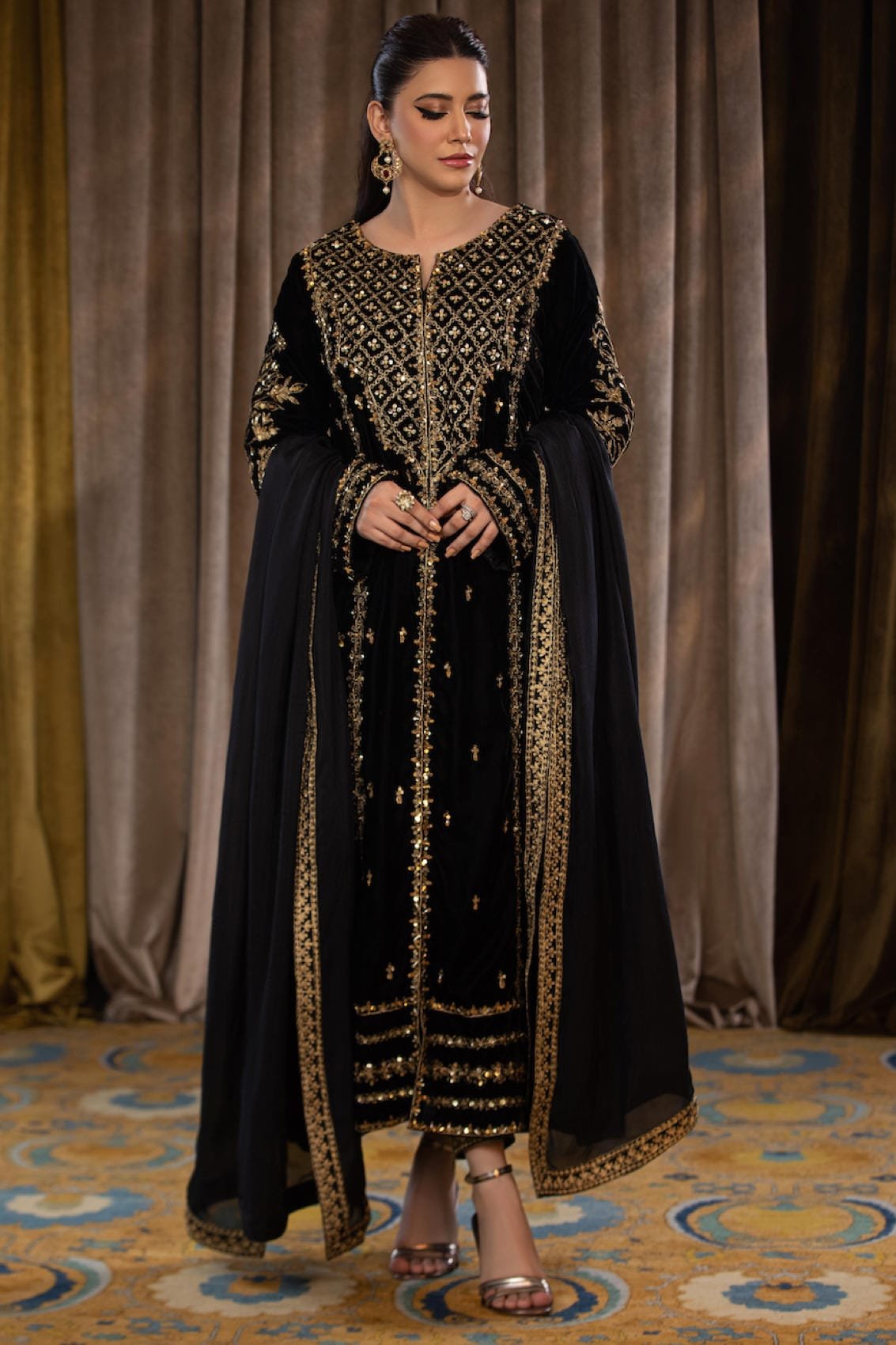Discover the Elegance: Top 5 Pakistani Suits from Arish Creation
Arish Creation offers a stunning collection of Pakistani suits that blend traditional craftsmanship with contemporary design. Here are five exquisite ensembles that will elevate your wardrobe:
1. Georgette Embroidered – Dazzle Collection

Immerse yourself in elegance with this Georgette embroidered suit. The intricate embroidery on premium Georgette fabric exudes timeless charm, making it a perfect choice for any special occasion.
2. Rosemeen Collection

Elevate your wardrobe with the timeless elegance of the Rosemeen collection. This ensemble features a Pure Cotton Embroidered top with meticulous craftsmanship, adding sophistication and charm to your look.
3. Organza Embroidered Ensemble with Santoon Bottoms

Indulge in sheer elegance with this Organza embroidered ensemble. The delicately embroidered top and matching dupatta, paired with Santoon bottoms, create a mesmerizing effect that captures attention.
4. Pure Fox Georgette Embroidered Ensemble

Experience the timeless allure of Pure Fox Georgette with this meticulously crafted ensemble. The intricate embroidered work showcases unparalleled craftsmanship and sophistication, making it a must-have for fashion enthusiasts.
5. Maria B Embroidered Wedding Dresses

Crafted with elegance and sophistication, the Maria B collection features an Organza top with delicate embroidery and meticulous handwork. The Heavy Embroidered Net dupatta and Plazo Santoon bottoms complete the regal look, perfect for weddings and grand celebrations.
Explore these beautiful Pakistani suits and more at Arish Creation. Each piece promises to add a touch of glamour and elegance to your ethnic wardrobe.
Hello world!
Welcome to WordPress. This is your first post. Edit or delete it, then start writing!
MAKE YOUR WEEKEND DELICIOUS
Sed utgio perspiciatis unde omnis iste natus error sit voluptatem accusantium doloremque laudantium, totam rem aperiam, eaque ipsa quae ab illo inventore veritatis et quasi architecto beatae vitae dicta sunt explicabo.Nemo enim ipsam voluptatem quia voluptas sit aspernatur aut odit aut fugit, sed quia consequuntur magni dolores eos qui ratione voluptatem sequi nesciunt. Typography is the work of typesetters, compositors, typographers, graphic designers, art directors, manga artists, comic book artists, graffiti artists, and now—anyone who arranges words, letters, numbers, and symbols for publication, display, or distribution—from clerical workers and newsletter writers to anyone self-publishing materials.
As the capability to create typography has become ubiquitous, the application of principles and best practices developed over generations of skilled workers and professionals has diminished. Ironically, at a time when scientific techniques.

Until the Digital Age, typography was a specialized occupation. Digitization opened up typography to new generations of previously unrelated designers and lay users, and David Jury, head of graphic design at Colchester Institute in England, states that “typography is now something everybody does. As the capability to create typography has become ubiquitous, the application of principles and best practices developed over generations of skilled workers and professionals has diminished. Ironically, at a time when scientific techniques.
THE LIFESTYLE OF YOUNG GIRL
Sed utgio perspiciatis unde omnis iste natus error sit voluptatem accusantium doloremque laudantium, totam rem aperiam, eaque ipsa quae ab illo inventore veritatis et quasi architecto beatae vitae dicta sunt explicabo.Nemo enim ipsam voluptatem quia voluptas sit aspernatur aut odit aut fugit, sed quia consequuntur magni dolores eos qui ratione voluptatem sequi nesciunt. Typography is the work of typesetters, compositors, typographers, graphic designers, art directors, manga artists, comic book artists, graffiti artists, and now—anyone who arranges words, letters, numbers, and symbols for publication, display, or distribution—from clerical workers and newsletter writers to anyone self-publishing materials.
As the capability to create typography has become ubiquitous, the application of principles and best practices developed over generations of skilled workers and professionals has diminished. Ironically, at a time when scientific techniques.

Until the Digital Age, typography was a specialized occupation. Digitization opened up typography to new generations of previously unrelated designers and lay users, and David Jury, head of graphic design at Colchester Institute in England, states that “typography is now something everybody does. As the capability to create typography has become ubiquitous, the application of principles and best practices developed over generations of skilled workers and professionals has diminished. Ironically, at a time when scientific techniques.
Make Your Weekend Delicious
Sed utgio perspiciatis unde omnis iste natus error sit voluptatem accusantium doloremque laudantium, totam rem aperiam, eaque ipsa quae ab illo inventore veritatis et quasi architecto beatae vitae dicta sunt explicabo.Nemo enim ipsam voluptatem quia voluptas sit aspernatur aut odit aut fugit, sed quia consequuntur magni dolores eos qui ratione voluptatem sequi nesciunt. Typography is the work of typesetters, compositors, typographers, graphic designers, art directors, manga artists, comic book artists, graffiti artists, and now—anyone who arranges words, letters, numbers, and symbols for publication, display, or distribution—from clerical workers and newsletter writers to anyone self-publishing materials.
As the capability to create typography has become ubiquitous, the application of principles and best practices developed over generations of skilled workers and professionals has diminished. Ironically, at a time when scientific techniques.
Shop The Look
Until the Digital Age, typography was a specialized occupation. Digitization opened up typography to new generations of previously unrelated designers and lay users, and David Jury, head of graphic design at Colchester Institute in England, states that “typography is now something everybody does. As the capability to create typography has become ubiquitous, the application of principles and best practices developed over generations of skilled workers and professionals has diminished. Ironically, at a time when scientific techniques.
The Lifestyle Of Young Girls
Sed utgio perspiciatis unde omnis iste natus error sit voluptatem accusantium doloremque laudantium, totam rem aperiam, eaque ipsa quae ab illo inventore veritatis et quasi architecto beatae vitae dicta sunt explicabo.Nemo enim ipsam voluptatem quia voluptas sit aspernatur aut odit aut fugit, sed quia consequuntur magni dolores eos qui ratione voluptatem sequi nesciunt. Typography is the work of typesetters, compositors, typographers, graphic designers, art directors, manga artists, comic book artists, graffiti artists, and now—anyone who arranges words, letters, numbers, and symbols for publication, display, or distribution—from clerical workers and newsletter writers to anyone self-publishing materials.
As the capability to create typography has become ubiquitous, the application of principles and best practices developed over generations of skilled workers and professionals has diminished. Ironically, at a time when scientific techniques.
Shop The Look
Until the Digital Age, typography was a specialized occupation. Digitization opened up typography to new generations of previously unrelated designers and lay users, and David Jury, head of graphic design at Colchester Institute in England, states that “typography is now something everybody does. As the capability to create typography has become ubiquitous, the application of principles and best practices developed over generations of skilled workers and professionals has diminished. Ironically, at a time when scientific techniques.
20 Of The Best Fashion Blogs To Follow In 2021
Typography is the work of typesetters, compositors, typographers, graphic designers, art directors, manga artists, comic book artists, graffiti artists, and now—anyone who arranges words, letters, numbers, and symbols for publication, display, or distribution—from clerical workers and newsletter writers to anyone self-publishing materials.
Sed utgio perspiciatis unde omnis iste natus error sit voluptatem accusantium doloremque laudantium, totam rem aperiam, eaque ipsa quae ab illo inventore veritatis et quasi architecto beatae vitae dicta sunt explicabo.
Nemo enim ipsam voluptatem quia voluptas sit aspernatur aut odit aut fugit, sed quia consequuntur magni dolores eos qui ratione voluptatem sequi nesciunt.
Typography is the work of typesetters, compositors, typographers, graphic designers, art directors, manga artists, comic book artists, graffiti artists, and now—anyone who arranges words, letters, numbers, and symbols for publication, display, or distribution—from clerical workers and newsletter writers to anyone self-publishing materials.






As the capability to create typography has become ubiquitous, the application of principles and best practices developed over generations of skilled workers and professionals has diminished. Ironically, at a time when scientific techniques.
Shop The Look
Until the Digital Age, typography was a specialized occupation. Digitization opened up typography to new generations of previously unrelated designers and lay users, and David Jury, head of graphic design at Colchester Institute in England, states that “typography is now something everybody does. As the capability to create typography has become ubiquitous, the application of principles and best practices developed over generations of skilled workers and professionals has diminished. Ironically, at a time when scientific techniques.
5 Ways To Create A Denim Look Better
Sed utgio perspiciatis unde omnis iste natus error sit voluptatem accusantium doloremque laudantium, totam rem aperiam, eaque ipsa quae ab illo inventore veritatis et quasi architecto beatae vitae dicta sunt explicabo.Nemo enim ipsam voluptatem quia voluptas sit aspernatur aut odit aut fugit, sed quia consequuntur magni dolores eos qui ratione voluptatem sequi nesciunt. Typography is the work of typesetters, compositors, typographers, graphic designers, art directors, manga artists, comic book artists, graffiti artists, and now—anyone who arranges words, letters, numbers, and symbols for publication, display, or distribution—from clerical workers and newsletter writers to anyone self-publishing materials.
Typography is the work of typesetters, compositors, typographers, graphic designers, art directors, manga artists, comic book artists, graffiti artists, and now—anyone who arranges words, letters, numbers, and symbols for publication, display, or distribution—from clerical workers and newsletter writers to anyone self-publishing materials.
As the capability to create typography has become ubiquitous, the application of principles and best practices developed over generations of skilled workers and professionals has diminished. Ironically, at a time when scientific techniques.
Until the Digital Age, typography was a specialized occupation. Digitization opened up typography to new generations of previously unrelated designers and lay users, and David Jury, head of graphic design at Colchester Institute in England, states that “typography is now something everybody does. As the capability to create typography has become ubiquitous, the application of principles and best practices developed over generations of skilled workers and professionals has diminished. Ironically, at a time when scientific techniques.
7 Things You Can’t Wear After Labor Day Read
Sed utgio perspiciatis unde omnis iste natus error sit voluptatem accusantium doloremque laudantium, totam rem aperiam, eaque ipsa quae ab illo inventore veritatis et quasi architecto beatae vitae dicta sunt explicabo.Nemo enim ipsam voluptatem quia voluptas sit aspernatur aut odit aut fugit, sed quia consequuntur magni dolores eos qui ratione voluptatem sequi nesciunt. Typography is the work of typesetters, compositors, typographers, graphic designers, art directors, manga artists, comic book artists, graffiti artists, and now—anyone who arranges words, letters, numbers, and symbols for publication, display, or distribution—from clerical workers and newsletter writers to anyone self-publishing materials.
As the capability to create typography has become ubiquitous, the application of principles and best practices developed over generations of skilled workers and professionals has diminished. Ironically, at a time when scientific techniques.

Until the Digital Age, typography was a specialized occupation. Digitization opened up typography to new generations of previously unrelated designers and lay users, and David Jury, head of graphic design at Colchester Institute in England, states that “typography is now something everybody does. As the capability to create typography has become ubiquitous, the application of principles and best practices developed over generations of skilled workers and professionals has diminished. Ironically, at a time when scientific techniques.




















